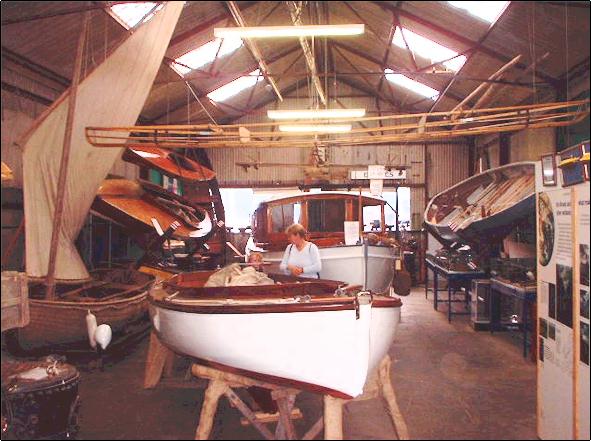I've just spent a week holidaying in a houseboat with my family on
the Broads, a group of tidal estuaries and medieval peat workings linked
by a network of canals and rivers in the low-lying county of Norfolk,
England, and I must say it's a very beautiful place. It's also an area
that has a number of characteristic boat styles that I thought some people
might like to see - and which some others might enjoy being reminded
about.
Here's a typical Broadland scene. This is often very low-lying
country, and just as in Holland wind pumps have traditionally been used to
control water levels.

Probably the most famous traditional boat type seen on these waters
is the Broads cruising yacht, typically an attractive gaff-rigged craft
with lots of brightwork. Large numbers are available for hire to
holidaying families. Many - including a whole fleet hired by the famous
Hunter's yard - have no engines and so the hirers often spend a good
amount of their time quanting their boats along the narrow channels. [I
haven't included any shots of the floating caravans used by many
holidaymakers on the grounds that they aren't really worth looking at.]
Vying for first place in the fame stakes is the Broads wherry. I
didn't see one myself, but I did find the model in the Museum of the
Broads, and took some shots of the wherry yacht Olive on Barton broad
(where Nelson learned to sail, it's said) and in the river near Ludham.
Far less frequently talked about are the gaff-rigged and balance
lug-rigged traditional half-decked sailing boats and the standing and
balance lug-rigged dinghies. On our trip I sailed several of these and can
thoroughly recommend the experience. I don't seem to have arrived home
with any pictures of the boats themselves, but here are my children and
myself sailing one. The wind was about Force 4 on this day and my son was
sadly feeling a little seasick at this point following a longish run down
Hickling Broad. :-(

One thing I noticed about these boats is that they have little if
any built-in bouyancy (emergency flotation in US English) and this puzzled
me until I sailed the boats myself and developed my own theory: why should
it be possible for the hire companies to survive in these litigious times
without this basic safety feature? My theory is that the answer is that
the sheets are organised in such a way that any gust above about Force 4
is close to pulling your shoulder out of its socket. Combined with steel
centreplates in the luggers and some half-deckers and keels in other half-deckers,
it's a neat solution that seems to allow hire companies to hire out
sailing boats to complete novices year after year in relative safety.
Worth thinking about, I'd say...
I also took some photos of the local type of shooting punt. The larger
punts pictured here in the museum are real old shooting punts, which were
sailed using small rigs. However, at some point racing broke out among the
punt users, sails increased in size and now the Norfok punt is one of the
fastest racing dinghy classes we have in the UK. I caught the beginning of
racing on Barton Broad, and so have included a couple of pictures.
A day trip to the seaside at Cromer gave me a chance to
take some shots of the local crab boats. The traditional boats are built
up at the sides and have holes for the oars, which I believe are used for
lifting. The built up sides are said also to have allowed the boats to be
beached sideways. On landing they were allowed to be knocked sideways by
the surf, and the crew simply stood inside while successive waves moved
the boat further up the beach while the extra strakes prevented the boat
from toppling over them. Notice that even the modern GRP crab boats, which
look to me to be derived from cobles or dories, have the same black upper
strake with oarholes.
These are pictures of the hull of a racing half-decker
on show at the Museum of the Broads;
This is a more general pic showing a variety of elderly
craft including more sailing punts, a pleasure steamer, and, top right, a
rescue craft used for recovering airmen during WWII. The boats, which were
rigged for sailing and had inflated bouyancy tanks fore and aft, were
parachuted into the airman's vicinity and he was expected to sail or motor
home. The whole thing was an idea of Uffa Fox's, and he designed the
thing. Said to be derived from the racing punt hull, many of the rescue
boats were converted for pleasure sailing on the Broads after the war.

I trust you can still breathe after this...
|